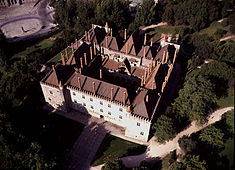Palace of the Dukes of Braganza
| Palace of the Dukes of Braganza (Paço dos Duques de Bragança) | |
| Palace (Palácio) | |
|
Aerial view of the Palace
|
|
| Official name: Paço dos Duques de Bragança | |
| Country | |
|---|---|
| Region | Norte |
| Sub-region | Aves |
| District | Braga |
| Municipality | Guimarães |
| Location | Oliveira do Castelo |
| - elevation | 219 m (719 ft) |
| - coordinates | 41°26′47.27″N 8°17′27.64″W / 41.4464639°N 8.2910111°WCoordinates: 41°26′47.27″N 8°17′27.64″W / 41.4464639°N 8.2910111°W |
| Length | 56.0 m (184 ft), Southwest-Northeast |
| Width | 61.0 m (200 ft), Northwest-Southeast |
| Architects | Mestre Antom, Rogério de Azevedo, Luís Benavente, António Viana Barreto |
| Materials | Masonry, Granite, Cement, Iron, Wood, Tiles, Azulejo, Stain-glass |
| Origin | c. 1420 |
| - Initiated | c. 1422 |
| Owner | Portuguese Republic |
| For public | Public |
| Visitation | Closed (1 January, Easter Sunday, 1 May and 25 December) |
| Easiest access | Rua Conde Dom Henrique |
| Management | Instituto Gestão do Patrimonio Arquitectónico e Arqueológico |
| Operator | Centro de eLearning do Instituto Politécnico de Tomar (IPT) e Área |
| Daily | 09:30 a.m.-6:00 p.m. |
| Status | National Monument |
| Listing | Decree No. 136, 23 June 1910 |
|
Website: pduques |
|
The Palace of the Dukes of Braganza (Portuguese: Paço dos Duques de Bragança), is a medieval estate and former residence of the first Dukes of Braganza, located in the historical centre of Guimarães (Oliveira do Castelo), in the north-western part of Portugal.
It was initiated between 1420 and 1422 by Afonso, Count of Barcelos, the illegitimate son of John I of Portugal (and future Duke of Bragança), after his marriage to his second wife. His prodigeny would occupy the space until the Dukes of Braganza moved to Vila Viçosa, abandoning the palace. The 16th Century marked the beginning of period of ruin, which was aggravated during the 19th century, when the local population used the palace as a personal quarry. During the Estado Novo regime, a controversial restoration restored the Palace, while implying a grandeur that may not have existed. The Palace of the Dukes was classified as a National Monument (Portuguese: Monumento Nacional) in 1910, and has been an official residence for the Presidency.
The residence was ordered to be built in the first quarter of the 15th century (likely 1420 to 1422) by Afonso, Count of Barcelos, the illegitimate son of John, and future Duke of Braganza, following his return to Portugal after a series of diplomatic missions to the Courts of France, Venice, Aragon and Castile. The construction of this building marked the concretization of his second marriage, when he took residence in the town. The project was given, as some authors have suggested, to French architect Antom. Yet, by 1442, it was still under construction when the Regent Peter came to Guimarães and stayed at the Palace, at the time conferring on his half-brother the title of 1st Duke of Braganza. The commission continued into 1461, when Afonso died: the property and titles passed on to his brother, Fernando, although the widow, Constança de Noronha, continued to live at the residence and received the land rents from the holdings in Guimarães.
...
Wikipedia


